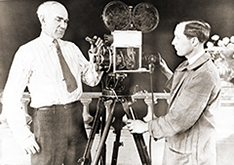Sound Film History
In 1919, American inventor Lee De Forest was awarded several patents that would lead to the first optical sound-on-film technology with commercial application. In De Forest's system, the sound track was photographically recorded on to the side of the strip of motion picture film to create a composite, or "married", print. If proper synchronization of sound and picture was achieved in recording, it could be absolutely counted on in playback. Over the next four years, he improved his system with the help of equipment and patents licensed from another American inventor in the field, Theodore Case.
 At the University of Illinois, Polish-born research engineer Joseph Tykociński-Tykociner was working independently on a similar process. On June 9, 1922, he gave the first reported U.S. demonstration of a sound-on-film motion picture to members of the American Institute of Electrical Engineers. As with Lauste and Tigerstedt, Tykociner's system would never be taken advantage of commercially; however, De Forest's soon would.
At the University of Illinois, Polish-born research engineer Joseph Tykociński-Tykociner was working independently on a similar process. On June 9, 1922, he gave the first reported U.S. demonstration of a sound-on-film motion picture to members of the American Institute of Electrical Engineers. As with Lauste and Tigerstedt, Tykociner's system would never be taken advantage of commercially; however, De Forest's soon would.
In Europe, others were also working on the development of sound-on-film. In 1919, the same year that DeForest received his first patents in the field, three German inventors, Josef Engl (1893–1942), Hans Vogt (1890–1979), and Joseph Massolle (1889–1957), patented the Tri-Ergon sound system. On September 17, 1922, the Tri-Ergon group gave a public screening of sound-on-film productions—including a dramatic talkie, Der Brandstifter (The Arsonist) —before an invited audience at the Alhambra Kino in Berlin. By the end of the decade, Tri-Ergon would be the dominant European sound system. In 1923, two Danish engineers, Axel Petersen and Arnold Poulsen, patented a system that recorded sound on a separate filmstrip running parallel with the image reel. Gaumont licensed the technology and briefly put it to commercial use under the name Cinéphone.
Domestic competition, however, eclipsed Phonofilm. By September 1925, De Forest and Case's working arrangement had fallen through. The following July, Case joined Fox Film, Hollywood's third largest studio, to found the Fox-Case Corporation. The system developed by Case and his assistant, Earl Sponable, given the name Movietone, thus became the first viable sound-on-film technology controlled by a Hollywood movie studio. The following year, Fox purchased the North American rights to the Tri-Ergon system, though the company found it inferior to Movietone and virtually impossible to integrate the two different systems to advantage. In 1927, as well, Fox retained the services of Freeman Owens, who had particular expertise in constructing cameras for synch-sound film. More details
 At the University of Illinois, Polish-born research engineer Joseph Tykociński-Tykociner was working independently on a similar process. On June 9, 1922, he gave the first reported U.S. demonstration of a sound-on-film motion picture to members of the American Institute of Electrical Engineers. As with Lauste and Tigerstedt, Tykociner's system would never be taken advantage of commercially; however, De Forest's soon would.
At the University of Illinois, Polish-born research engineer Joseph Tykociński-Tykociner was working independently on a similar process. On June 9, 1922, he gave the first reported U.S. demonstration of a sound-on-film motion picture to members of the American Institute of Electrical Engineers. As with Lauste and Tigerstedt, Tykociner's system would never be taken advantage of commercially; however, De Forest's soon would.In Europe, others were also working on the development of sound-on-film. In 1919, the same year that DeForest received his first patents in the field, three German inventors, Josef Engl (1893–1942), Hans Vogt (1890–1979), and Joseph Massolle (1889–1957), patented the Tri-Ergon sound system. On September 17, 1922, the Tri-Ergon group gave a public screening of sound-on-film productions—including a dramatic talkie, Der Brandstifter (The Arsonist) —before an invited audience at the Alhambra Kino in Berlin. By the end of the decade, Tri-Ergon would be the dominant European sound system. In 1923, two Danish engineers, Axel Petersen and Arnold Poulsen, patented a system that recorded sound on a separate filmstrip running parallel with the image reel. Gaumont licensed the technology and briefly put it to commercial use under the name Cinéphone.
Domestic competition, however, eclipsed Phonofilm. By September 1925, De Forest and Case's working arrangement had fallen through. The following July, Case joined Fox Film, Hollywood's third largest studio, to found the Fox-Case Corporation. The system developed by Case and his assistant, Earl Sponable, given the name Movietone, thus became the first viable sound-on-film technology controlled by a Hollywood movie studio. The following year, Fox purchased the North American rights to the Tri-Ergon system, though the company found it inferior to Movietone and virtually impossible to integrate the two different systems to advantage. In 1927, as well, Fox retained the services of Freeman Owens, who had particular expertise in constructing cameras for synch-sound film. More details
